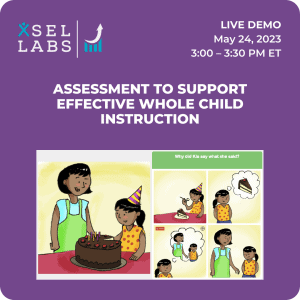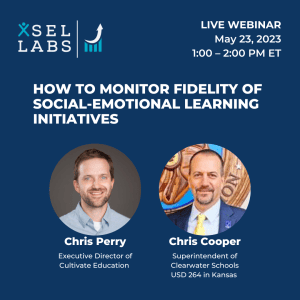Over the past few months, I’ve had the good fortune of leading a handful of workshops for educators on SEL assessment. It’s always a privilege to speak with my colleagues who work in schools. SEL and its assessment is pretty new for many, and during the workshops, I do what I can to support a broader understanding of how to assess student social and emotional competence and how to use social and emotional competence assessment data to inform instructional decision-making.
Can I share a secret? I learn at least as much from these workshops as the participants do.
Beyond SEL Assessment to Screen for Risk
As I’ve mentioned in recent blog posts, one thing I’ve learned over the last few workshops is that many educators have a particular view of SEL assessment that is not wrong, but that also does not recognize the high-quality tools that are available and the many uses to which they can be put.
Many times, when I ask educators at workshops what they are doing to assess student social and emotional competence, they mention a screener—typically a teacher rating form—designed to identify students at risk of internalizing, externalizing, or academic problems. There’s nothing wrong with this. Screening is important. But, as I have discussed previously, the SEL endeavor at its best is much more about nurturing desirable competencies than about eliminating undesirable problems. The goal is to teach children how to engage each other and their “work” constructively so they can succeed, not to treat and cure disorders that interfere. One of the paradoxes of the field is that equipping students with social and emotional competencies reduces the likelihood of the problems we so often try to cure.
Because SEL is about nurturing competencies, not treating problems, screening to identify problems as an assessment goal is not a particularly good fit with the spirit of the field. My work, and my workshops, focus on how to use high-quality social and emotional competence assessment data to guide instruction, much in the way a good formative reading or math assessment might help a teacher decide what to teach to whom. In this model, SEL assessment is not undertaken to identify problems to treat; it is used to guide what to teach to whom at what point, and to measure progress in response to instruction. That model of SEL assessment is not generally familiar to workshop participants, but by the end, most see and are intrigued by the possibilities.
If Not Screening, What is It?
At the end of the last workshop, someone asked me, “What do you call that kind of assessment? I get that it’s not screening. So what is it?”
Sometimes, I describe this as “formative assessment,” or assessment designed to guide instruction. But that often doesn’t seem to hit home to workshop participants, and it didn’t this time either, so I asked them what they would call it.
One inspired workshop participant said she would call assessment as I was describing it an “instructional planning tool.” A quick glance around the room and it was clear that this description resonated with her fellow workshop participants.
I like it too. Instructional planning tool. Like any good label, it describes the thing in a compact and easy-to-understand way. It describes SEL assessment as an important tool for planning what competencies to teach to whom.
SEL Assessment as an Instructional Planning Tool
So how can SEL assessment help educators plan instruction? I’ve written about this in a blog post and a follow up post. And we have a free guide to data-informed instruction. I also wrote a book about this. In short, there are lots of places you might turn for more.
But if you’re pressed for time, here’s a quick overview:
- Find an assessment that is designed to measure the social and emotional competencies you intend to teach, perhaps with the support of an evidence-based SEL program.
- Administer the assessment early in the period of SEL instruction.
- Become familiar with what the assessment is designed to measure and what the scores mean.
- Review, preferably along with your colleagues, findings from this first administration of the assessment.
- Identify, in your group of students, areas of strength and areas of need.
- Emphasize the lessons in your SEL program’s scope and sequence that are designed to teach competencies students particularly need to learn. Beyond curriculum, identify ways throughout the course of the day to build on student strengths and address student needs.
- After a period of instruction, re-assess to see how students are progressing.
This should sound familiar. It’s what educators around the country (world?) do to teach academic competencies. If you’re like me, and you think social and emotional competencies can and should be taught, then let’s use SEL assessment as… you guessed it: an instructional planning tool!
SELweb, our direct assessment for K to 6, is designed to measure competencies that are the target of instruction in the most widely used evidence-based SEL programs. At its best, it’s an instructional planning tool, designed to measure competencies directly so you know what to teach to whom.
I invite you to get on my calendar for a Zoom meeting to learn more.



